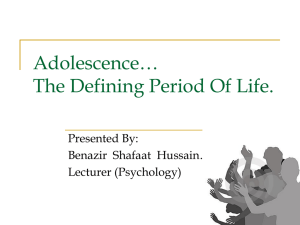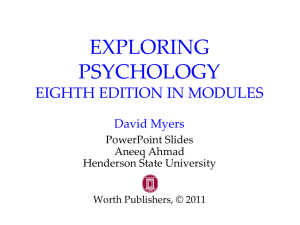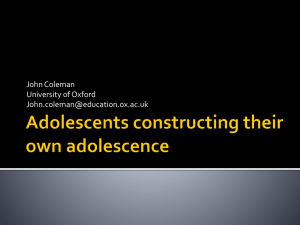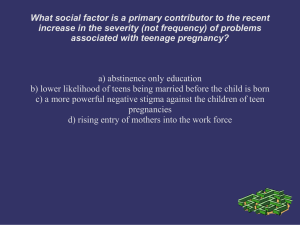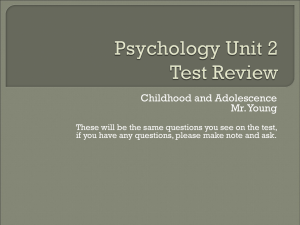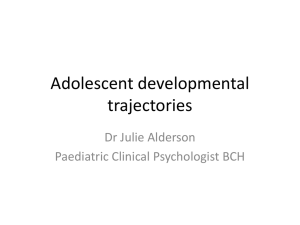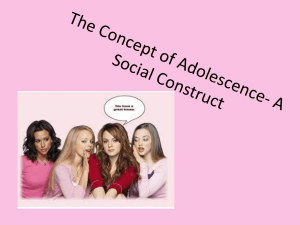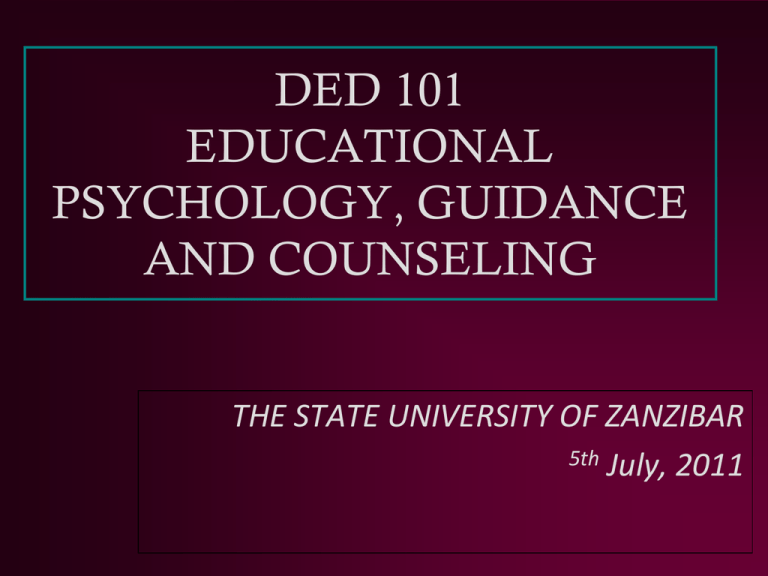
DED 101
EDUCATIONAL
PSYCHOLOGY, GUIDANCE
AND COUNSELING
THE STATE UNIVERSITY OF ZANZIBAR
5th July, 2011
OUTLINE
•
•
•
•
Meaning of Adolescence
Adolescence’s needs
Adolescence’s problems
Dealing with adolescence so as to:
• Perform well in their learning
• Positive adaptation to their environment
DEFINTIONS
• (Oxford Concise Dictionary:2009) defines adolescence
as the period following the onset of puberty during
which a young person develops from a child into an
adult.
• (Holmbeck:1994) defines adolescence as a transitional
period between childhood and adulthood which is
characterized by a host of biological, psychological,
and social rol changes.
• (Baron:1996) defines adolescence as a period
beginning with the onset of puberty and ending when
individuals assume adult roles and responsibilities
Stages of Adolescence
• Early Adolescence: 12-15 yrs; a time for selfconciseness.
• Middle Adolescence: 15-18yrs; interest in
opposite sex, sex role expectations.
• Late Adolescence: 18-22; education, career,
marriage, children, and life-style.
Physical Development
• The biological changes that occur during adolescence
are greater than those of any other time of life, with
the exception of infancy.
• Unlike the newborn, adolescents are aware of the
changes that are taking place and of what the changes
mean. These changes and this awareness may be
pleasing or horrifying; lack of information about
puberty/sexuality can contribute to emotional upset
• The sequence of events at puberty is generally the
same for each person, the timing and the rate at which
they occur vary widely.
5
Chapter 11
Physical Development
• Puberty—specific developmental changes that lead to the ability to
reproduce.
Primary sex characteristics—directly involved in reproduction.
• The body organs and reproductive structures and functions that
differ between women and men.
• Gonads (testes and ovaries)
• Secondary sex characteristics—not directly involved in
reproduction
– Examples: growth of hair on certain parts of the body
– Deepening of the voice
and
6 – In females, rounding of hips
Chapter
11 breast
Physical Development
• Changes in Males
– Pituitary gland causes the testes to increase
output of hormone testosterone
– Sexual organs grow
– Voices deepen
– Hair begins to grow on face, and later on chest
– Develop broader shoulders and thicker bodies
– Develop muscle tissue and larger hearts and lungs
7
Chapter 11
Physical Development
PHYSICAL CHANGES IN FEMALES
• Hormones from the pituitary gland stimulate the
ovaries to secrete more estrogen which spurs the
growth of breasts.
• First menstrual cycle usually begins between the
ages of 11 to 14.
• Pelvic region widens, hips become rounder
How teachers can support the physical
development of young adolescent students
• Respect and understand the physical changes that
students are going through.
• Vary instructional methods to allow for physical
activity and movement
• Vary instructional methods to allow for physical
activity and movement
• Allow enough time in the school schedule for
developing physical fitness.
• Allow for stretch, bathroom, and snack breaks during
long blocks
• of time.
Adolescent’s Needs
• It doesn't matter what stage of life you are in,
everyone has the same basic needs. These
needs can be physical, emotional, social,
intellectual, spiritual, and creative.
• When all of these needs are satisfied, you'll
discover that your life is brimming with joy
and good feelings. You'll find your self-esteem
at its highest peak whenever you are fulfilled
within your daily life and activities.
Adolescence’s Social Needs
• Young adolescents are becoming aware of the larger world around
them for the first time. They are beginning to consider themselves as
individuals outside of their families
• Needing to belong to the peer group is probably the strongest single
characteristic of adolescence.
• Who am I? How do I fit in? What does everyone think about me? are
questions constantly running through young adolescents’ heads as they
experiment with their new independence and develop strong
relationships with their peers
• Social and emotional concerns(needs) often block out academic issues.
The young adolescent’s primary lens is that of social interaction: finding
one’s place in the social context
• As the world of young adolescents expands and they begin to develop
their own beliefs, attitudes, and values, the media, adults outside the
family, and peers influence their decisions more and more.
Everyone needs to belong — to feel
connected with others and be with
others who share attitudes, interests,
and circumstances that resemble
their own. People choose friends who
accept and like them and see them in
a favorable light.
Social Needs
• Need to make personal choices
• Need for social acceptance
• Need for relations with the opposite sex, but same sex
friendships dominate
• Need to define sex role characteristics
• Need for independence
• Need of adults’ identification but not always willing to accept
their suggestions
• Need for frequent reinforcement that significant adults including
parents care
• Need moderate amounts of time alone, in order to regroup and
reflect on daily experiences
•
•
•
•
•
•
•
How teachers can support the social needs
of young adolescent students?
Provide cooperative learning opportunities as well as time for large
group and one-on-one discussions.
Require students to apply their knowledge and skills to social issues
and topics of concern to young people.
Maintain clear expectations for social interaction.
Create learning experiences in which students practice democracy,
governance, and conflict resolution
Foster opportunities for personal reflection and for students to share
their concerns and feelings with teachers.
Foster classroom and team identity, and provide time for regular
student-led meetings to discuss issues, plan events, and make
important decisions regarding the team.
Create peer editing, tutoring, and mentoring activities.
Personal and Learning Needs
• Adolescents like anybody else have personal needs that need
to be fulfilled.
• It is common to adjust one’s personal goals and beliefs as
one matures and views the world from a new or broader
perspective.
• Personal needs of adolescents includes the need to identity
formation which is the process of developing a sense of who
one is and what one stands for. Thus personal needs include:
o Need to have a sense of individual self
o Need for Selection of commitments, beliefs, values
o Need to experiment with different values, beliefs, roles,
and relationships.
Learning Needs
• Young adolescent learners are curious, motivated to
achieve when challenged, and capable of critical and
complex thinking.
• This group of students can be both a delight and a
challenge for teachers to motivate, hold their attention,
and channel their enthusiasm and energy into real learning.
• As adolescents learn they focus mainly on self relation and
thus they ask themselves these questions Why does this
matter to me?” “How can I help or influence this situation?”
• “How good will I be at this?” “What are others doing and
thinking?” “What will they think of me?”
Learning needs
• Learning needs of adolescents, include necessary competencies
such as:
• self-esteem,
• self-reliance,
• teamwork/cooperation,
• respect for diversity and the rights of others,
• peaceful negotiation and conflict resolution,
• cultural awareness,
• creative thinking/innovation,
• acquiring and using appropriate information,
How teachers can support the learning needs of young
adolescent students
• Each and every middle school teacher needs to develop strong
relationships with his or he students. Such relationships are the
foundation for powerful learning.
• Focus on complex thinking skills that ask students to apply their
knowledge and skill to worthwhile tasks.
• Ask students to make choices and pursue their own interests.
• Provide cooperative learning opportunities, one-on-one
feedback, and time for personal reflection.
• Differentiate instruction.
Remember
By taking time to listen to
students and personalize their
learning, schools can help
young adolescents feel safer
and less vulnerable to criticism,
less concerned with their
changing bodies, and more
aware that they are not alone
with their personal problems
and feelings, that these are
natural and often shared
experiences among people.
Adolescence’s Problems
• The physical and psychological characteristics
of adolescents and the nature of
developmental tasks which they are expected
to perform often pose certain challenges and
problems for adjustment. Basically adolescents
face problems related to their home, school
and society. They are presented in Table 1
Table 1
Social Problems
Academic
problems/school
problems
Self problems
Home related
problems
Gender bias,
caste
related
problems
Generation gap
Practices
Over
expectations
Lack of friends
Strict teachers
Closed school
atmosphere
Not acceptable
classmates
Poor marks
Too much
homework
No co-curricular
participation.
Long school
hours
Body image
Pimples
Body changes
Moodiness
Anger
Feeling of rebel
Crushes
Day dreams
Personality
Authoritative
parenting
Poor rapprt with
parents
Lack of
communication
Low socioeconomic
background
Non conducive
atmosphere
Space constraint
Comparison with
others
Adolescence’s Problems
• The major problems that adolescents face
include :
• Increased risk for delinquent behaviors.
• Increased risk of depression and anxiety.
• Impaired cognitive and school perfomance
• Difficulties in forming meaningful
relationships including stable romantic ones
Helping Adolescents Counseling
and Guidance
• Adolescence is a phase which makes a person enter into the
adult world. Growing into an adult a child makes us experience
the problems in various domainssuch as
• Personal
• Social
• Educational
• Vocational and career related
• Through guidance and counseling services adolescents can be
helped to solve these problems. With the help of career
counseling and vocational guidance they can be helped with
insights into the various career opportunities and educations
choices that are available. Personal and social counseling can
help them in resolving their problems
Remember
• Adolescence is an important stage in the life span of human
beings. It serves as the bridge between childhood and adulthood.
• This period is marked by rapid physical and psychological
transformation of the individual.
• The sex characteristics develop during this phase.
• This is period during which significant bodily changes occur that
characterize.
• Some of the developmental tasks of adolescents are achieving
new and mature relations with mates, achieving
masculine/feminine social role, achieving lindependence etc
• The adolescents face problems related to home, self, school and
society.
• The process of guidance and counseling can help the adolescent
for a smooth transition of adulthood..
Questions?
Can you answer these questions?
• Question:
1. How do males and females change physically during adolescence, and
what are the psychological effects of these changes?
2. What role do parents and peers play in the lives of adolescents?
3. What reasons might we have for thinking adolescents are particularly
vulnerable to aggression/violence?
4. Why do adolescents become increasingly aware of their cultural roles
and what is expected of them?
5. What are some of the challenges that adolescents face in today’s
society?
THANK YOU FOR
LISTENING
END OF LECTURE SEVEN


